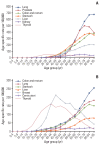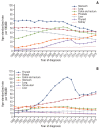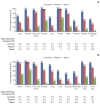Cancer Statistics in Korea: Incidence, Mortality, Survival, and Prevalence in 2019
- PMID: 35313102
- PMCID: PMC9016309
- DOI: 10.4143/crt.2022.128
Cancer Statistics in Korea: Incidence, Mortality, Survival, and Prevalence in 2019
Abstract
Purpose: The current study provides national cancer statistics and their secular trends in Korea, including incidence, mortality, survival, and prevalence in 2019.
Materials and methods: Incidence, survival, and prevalence rates of cancer were calculated using the Korea National Cancer Incidence Database, from 1999 to 2019, with survival follow-up until December 31, 2020. Deaths from cancer were assessed using causes-of-death data obtained from Statistics Korea.
Results: In 2019, newly diagnosed cancer cases and deaths from cancer were reported as 254,718 (ASR, 275.4 per 100,000) and 81,203 (ASR, 72.2 per 100,000), respectively. For the first time, lung cancer (n=29,960) became the most frequent cancer in Korea, excluding thyroid cancer. The overall cancer incidence rates increased by 3.3% annually from 1999 to 2012, and decreased by 5.3% annually from 2012 to 2015, thereafter, followed by nonsignificant changes. The incidence of thyroid cancer increased again from 2016 (annual percentage change, 6.2%). Cancer mortality rates have been decreasing since 2002, with more rapid decline in recent years (annual decrease of 2.7% from 2002 to 2013; 3.3% from 2013 to 2019). The 5-year relative survival between 2015 and 2019 was 70.7%, which contributed to prevalent cases reaching over 2 million in 2019.
Conclusion: Cancer survival rates have improved over the past decades, but the number of newly diagnosed cancers is still increasing, with some cancers showing only marginal improvement in survival outcomes. As the number of cancer survivors increases, a comprehensive cancer control strategy should be implemented in line with the changing aspects of cancer statistics.
Keywords: Incidence; Korea; Mortality; Neoplasms; Prevalence; Survival.
Conflict of interest statement
Conflict of interest relevant to this article was not reported.
Figures







References
-
- Ferlay J, Ervik M, Lam F, Colombet M, Mery L, Pineros M, et al. Global cancer observatory: cancer today [Internet] Lyon: International Agency for Research on Cancer; 2020. [cited 2022 Feb 13]. Available from: https://gco.iarc.fr/today .
-
- Bray F, Laversanne M, Weiderpass E, Soerjomataram I. The ever-increasing importance of cancer as a leading cause of premature death worldwide. Cancer. 2021;127:3029–30. - PubMed
-
- Statistics Korea [Internet] Daejeon: Statistics Korea; 2020. [cited 2022 Feb 13]. Available from: http://kosis.kr .
-
- Ajiki W, Tsukuma H, Oshima A. Index for evaluating completeness of registration in population-based cancer registries and estimation of registration rate at the Osaka Cancer Registry between 1966 and 1992 using this index. Nihon Koshu Eisei Zasshi. 1998;45:1011–7. - PubMed
MeSH terms
Grants and funding
LinkOut - more resources
Full Text Sources
Medical
Research Materials
Miscellaneous

